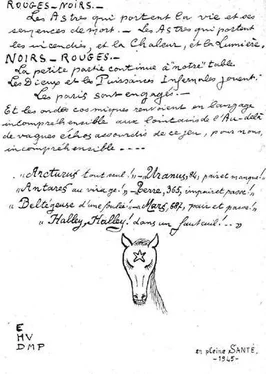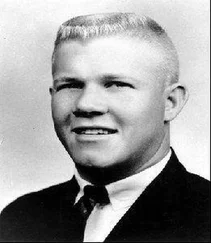On May 21, 1943, Beretta arrived at the hair salon for his scheduled departure. Fourrier and the makeup artist Pintard were there, but not Dr. Eugène. Berger sensed that the agency’s leader might have become suspicious, perhaps even had been tipped off about the raid. He ordered his Gestapo men to pounce. Agents exiting black Citroëns dashed into the salon and threw the men to the ground as they accepted payment.
When Jodkum learned of this arrest, he was livid. He would have preferred to watch the organization longer to discover its inner workings, not just its recruiters, who were easy enough to identify and arrest. Jodkum wanted the more shadowy agents who guided clients across the frontier, the officials who helped with the false paperwork, and, of course, the leader of the organization himself and the reputed treasure, all of which he feared would now be harder to seize. He blamed Berger’s panicked arrest for spoiling his opportunity. As a higher authority, Jodkum pulled rank and seized control of the interrogations.
The prisoners were handed over to Jodkum, with apologies. The hairstylist and makeup artist at first denied everything, but as questioning soon turned brutal, both men admitted working for a well-connected physician known as Dr. Eugène. He smuggled clients out of Occupied France across the mountains into the Free Zone, or abroad, passing through Andorra and then Spain, where they were put on a ship to Argentina. He also obtained false passports and other required travel documents for his clients. The doctor, they confessed, lived at 66 rue Caumartin.
WAS Marcel Petiot really Dr. Eugène, the man the Gestapo suspected of helping desperate people escape Occupied Paris? What implications, if any, did the Gestapo file have for discovering the identity of the remains at rue Le Sueur? And what had happened to Yvan Dreyfus?
By six o’clock on May 21, 1943, three hours after the arrest of the hairdresser and makeup artist, the Gestapo had stormed Marcel Petiot’s apartment and hauled him off to their headquarters in the imposing former French Ministry of Interior, at 11 rue Saussaies. They also arrested his old friend, René Nézondet, who had just arrived with theater tickets for the night’s performance of Champi’s musical comedy Ah, la Belle Epoque! at Théâtre Bobino.
Gestapo headquarters was an intimidating place even to its own officers. Former member Hans Gisevius described the atmosphere that prevailed in Berlin—and the tension could certainly apply to the office in Paris:
[It was] a den of murderers.… We did not even dare step ten or twenty feet across the hall to wash our hands without telephoning a colleague beforehand and informing him of our intention to embark on so perilous an expedition
.
His colleague, Arthur Nebe, entered and exited the building using the back staircases, “with his hand always resting on the cocked pistol in his pocket.”
Dragged past the armed guards, Petiot was taken to a room on the fourth floor for questioning. He would later claim that the Gestapo had beaten him savagely at one point after his arrest, every hour throughout the night. The first few days—“three days and two nights,” as he put it—Petiot was shuttled between this building and other offices, including a branch of the military espionage and counterespionage organization, Abwehr, at 101 Avenue Henri-Martin.
Petiot suffered a series of brutal interrogations. As he described it, they drilled and filed his teeth, and put his head in a vise (“skull crushing”), causing him to spit blood for days and suffer excruciating cases of vertigo for a long time afterward. He was also given “the bath,” the technique of stripping a prisoner naked and then submerging him, headfirst, with arms and feet bound in chains, into icy water until he fell unconscious, at which point he was revived and the torture repeated. He was eventually dressed and sent in his soaking wet clothes to shiver away in a cold cell.
Sometimes prisoners faced other savage treatment, such as crushing or twisting of the testicles, or electric currents running through the hands, feet, and ears, with one end attached to the rectum and the other to the penis. There is no evidence that Petiot received either of the latter, but these served, along with the lash, the whip, the bath, and the vise, in the arsenal of interrogation methods used in Gestapo offices in France and elsewhere in Occupied Europe. It was called “running a prisoner through the dance.”
Petiot was interned at Fresnes Prison, a white stone structure seven miles outside of Paris that was at that time the largest prison in France and indeed the continent. It was also a notorious holding place for Resistants, captured British agents, and other enemies of the Third Reich. Petiot was detained in cell 440 on the fourth floor of the first division.
The cells in the long corridors were small, with a chair, a table, and an iron cot chained to the wall and covered by a straw mattress often infested with fleas or other bugs. Near the table were an open toilet and a single brass faucet. Graffiti was sometimes scratched or penciled into the walls, offering a glimpse into the spirit of the prisoners—many of them marshaling their resources in expectation of the next interrogation.
In cell 44 of the Second Division, American Sergeant H. Hilliard scrawled his name, the date “June 1943,” and the words “God bless America.” Guy Gauthier (alias André Nantais) of the Resistance network Franc-Tireurs et Partisans (FTP), locked in cell 205 of the Second Division, wrote, “Live Free or Die Fighting. France Free Yourself.” Cell 147 noted the death of “Mazera Dédé, innocent victim of the Gestapo,” while someone in cell 34 had drawn a heart with a pierced arrow and the letters R and L. He added not “Vive de Gaulle,” but “Vive le fin de la guerre.”
Like many other people arrested together, Marcel Petiot and René Nézondet had been separated upon arrival. Eight days later, Nézondet saw his friend again when both men stood outside the main entrance at Fresnes awaiting transfer from their cells for further questioning at Gestapo headquarters. Petiot was, Nézondet said, a pitiful sight. Handcuffed and chained at his ankles, Petiot “seemed to have great difficulty moving. He stood slightly stooped and patted his head constantly with a wet handkerchief.”
What, in the end, did Petiot admit to his interrogators? According to his confession, which he had been forced to sign, Petiot was not the main leader of the escape organization. He claimed to work for a patient in his medical practice named Robert Martinetti, or the “Martinetti Organization.”
Petiot had begun this work, he told his interrogators, one day in November 1941 when the alleged Martinetti informed him of the escape route to South America and asked if any of his clients wanted to use it. Months later, Petiot asked one of his patients, the hairdresser Charles Fourrier (his name was actually Raoul Fourrier), who in turn agreed to send him people wanting to leave Paris. Petiot met the potential clients at the rendezvous, usually at or near Place de la Concorde, such as outside the entrance to the métro at rue de Rivoli or, alternatively, in front of the station at Saint-Augustin. From here, he claimed to take them to Martinetti. The charge was at first 25,000 francs, though it later increased to 50,000 or higher, depending on the case.
Departures had begun in late 1942, Petiot said, pleading ignorance of most of the details about the organization, its escape route, and its hideaways. “All I knew, and all I was supposed to know, was Martinetti and delivering the travelers to him,” Petiot declared. Explaining why he was questioning Dreyfus if he were only a cog in the machine as he claimed, Petiot said that he had become skeptical of many people that Fourrier brought to him. He had taken it upon himself to examine candidates for their suitability.
Читать дальше












